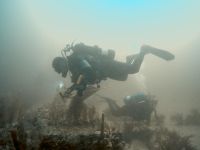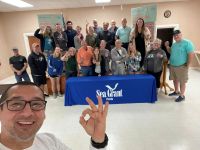Citizen Science Volunteers in a Marine Extension Program: Artificial reef fish monitoring case study
By Victor Blanco
Florida Sea Grant – University of Florida IFAS Extension
 Taylor and Dixie Counties in Florida have become key players in Florida’s marine habitat restoration, emphasizing the crucial role of artificial reefs. Their respective monitoring programs reveal the profound impact of volunteer divers, the challenges faced, and the lessons learned in advancing these efforts.
Taylor and Dixie Counties in Florida have become key players in Florida’s marine habitat restoration, emphasizing the crucial role of artificial reefs. Their respective monitoring programs reveal the profound impact of volunteer divers, the challenges faced, and the lessons learned in advancing these efforts.
The success of Taylor and Dixie Counties’ artificial reef monitoring programs heavily relies on a robust network of volunteer divers. In Taylor County, social media campaigns attracted community members eager to contribute to marine conservation. These volunteers participated in extensive training sessions, including fish identification, reef structure assessment, and data collection protocols. Training sessions ensured that volunteers met standardized methodologies, such as the Stationary Visual Census and Roving Diver techniques, which improved data reliability.
In Dixie County, volunteers underwent similar rigorous preparation. Training included hands-on workshops and interactive sessions to foster competency in assessing reef materials and observing marine species. As a result, volunteers across both counties contributed significantly, logging significant hours in surveys, with many trained divers returning annually to strengthen long-term monitoring efforts.
Despite notable progress, the programs faced several challenges. The most significant included weather disruptions, locating reef sites during dives, and maintaining engagement over time. Locating reef sites often required advanced sonar equipment. Volunteer retention was another challenge; balancing schedules and ensuring availability for extended fieldwork required strategic planning and consistent communication.
disruptions, locating reef sites during dives, and maintaining engagement over time. Locating reef sites often required advanced sonar equipment. Volunteer retention was another challenge; balancing schedules and ensuring availability for extended fieldwork required strategic planning and consistent communication.
In both counties, funding constraints and logistical hurdles occasionally delayed surveys. These challenges underscored the importance of community partnerships and resource sharing to enhance program resilience and execution.
Key takeaways from these programs emphasize the need for adaptive management and continuous volunteer engagement. Simplified but robust training modules and leveraging partnerships with local organizations enhanced volunteer retention. Open communication and acknowledgment of volunteer contributions fostered a sense of ownership and pride among participants.
Expanding the partnership between Taylor and Dixie Counties offers opportunities for collective funding and resource optimization. Regional collaborations could increase financial allocations for habitat restoration projects and enable broader ecological assessments. Additionally, fostering partnerships with neighboring counties could lead to a sustainable rotating funding model for artificial reef maintenance and monitoring.
The dedicated efforts of volunteer divers, coupled with community-driven initiatives, continue to enhance artificial reef ecosystems in Taylor and Dixie Counties. These programs demonstrate the power of grassroots conservation, setting a benchmark for similar initiatives across Florida and US. As the scope of these programs grows, their impact on marine biodiversity and local economies remains a testament to collaborative conservation efforts.


 Taylor and Dixie Counties in Florida have become key players in Florida’s marine habitat restoration, emphasizing the crucial role of artificial reefs. Their respective monitoring programs reveal the profound impact of volunteer divers, the challenges faced, and the lessons learned in advancing these efforts.
Taylor and Dixie Counties in Florida have become key players in Florida’s marine habitat restoration, emphasizing the crucial role of artificial reefs. Their respective monitoring programs reveal the profound impact of volunteer divers, the challenges faced, and the lessons learned in advancing these efforts. disruptions, locating reef sites during dives, and maintaining engagement over time. Locating reef sites often required advanced sonar equipment. Volunteer retention was another challenge; balancing schedules and ensuring availability for extended fieldwork required strategic planning and consistent communication.
disruptions, locating reef sites during dives, and maintaining engagement over time. Locating reef sites often required advanced sonar equipment. Volunteer retention was another challenge; balancing schedules and ensuring availability for extended fieldwork required strategic planning and consistent communication.